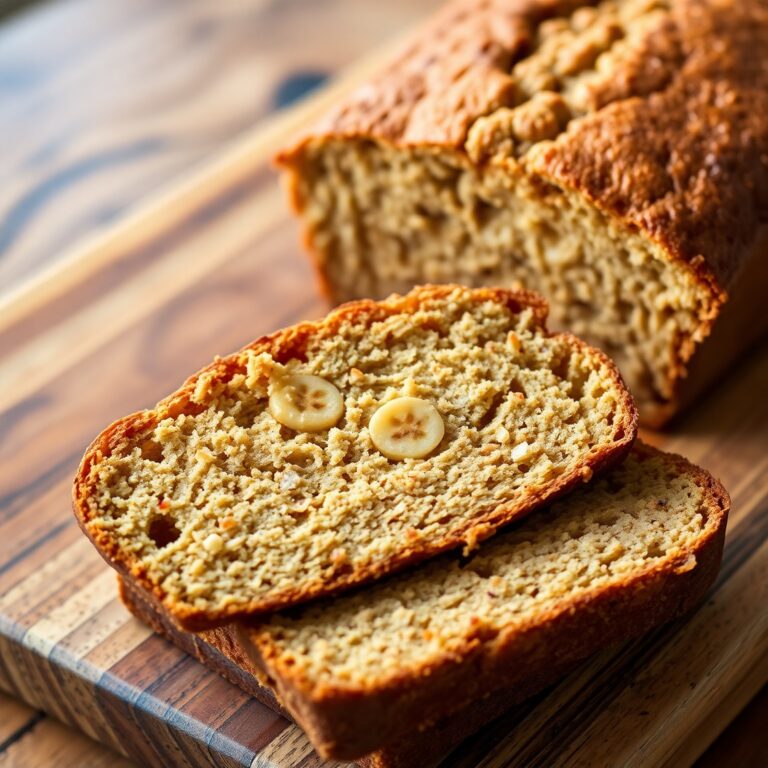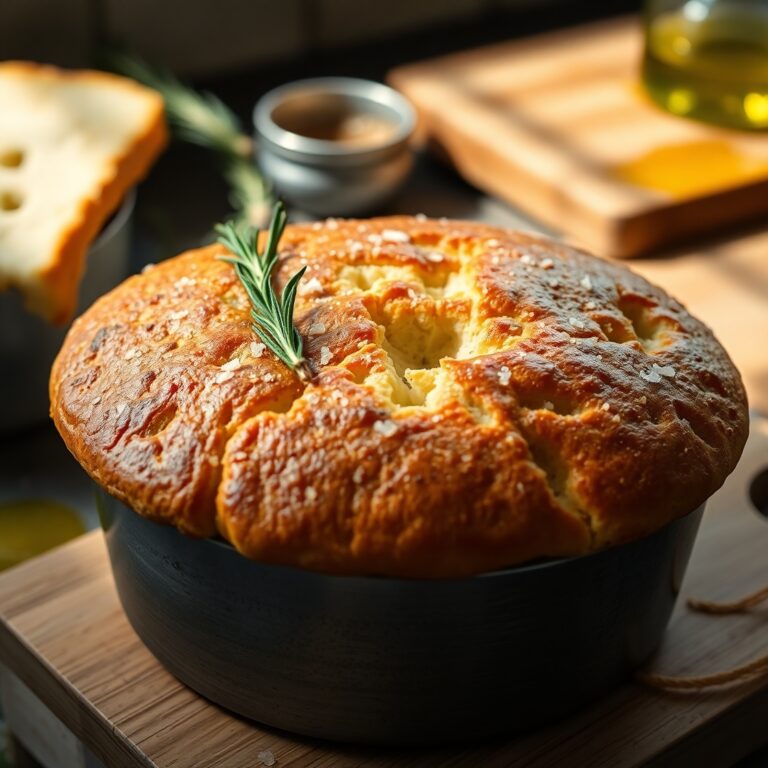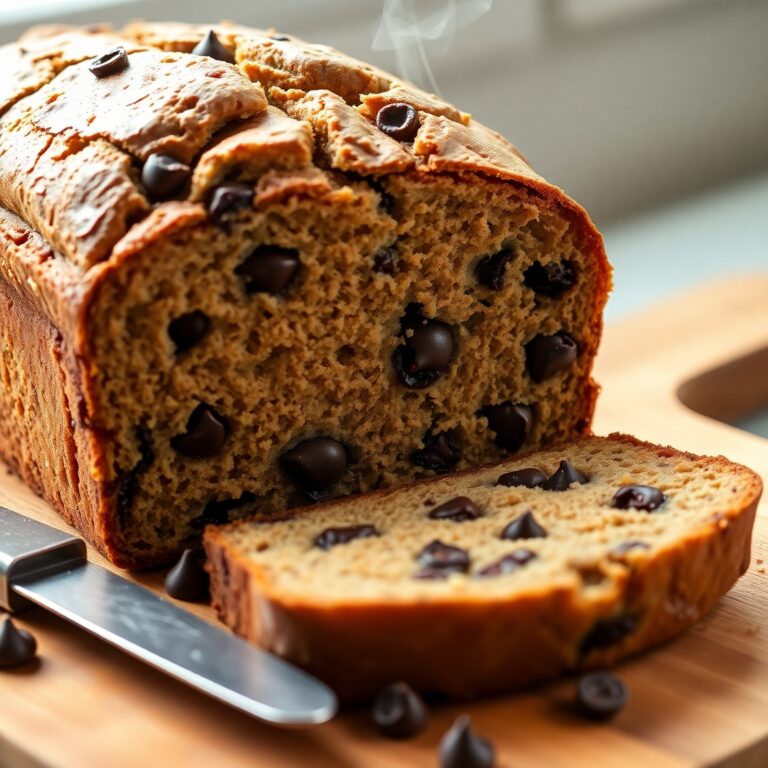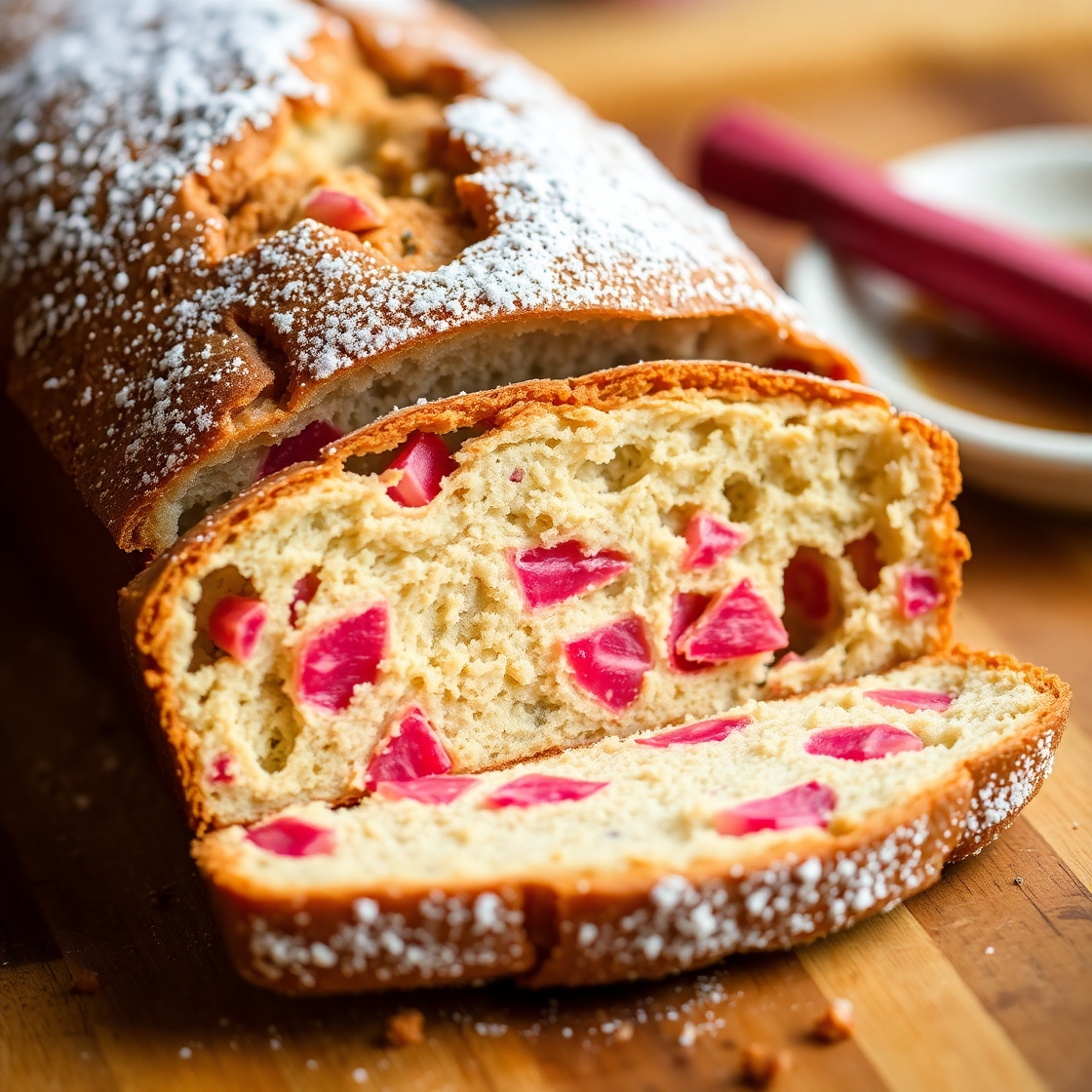
Every spring, rhubarb appears like a secret invitation to bake something special—something nostalgic. This rhubarb bread is exactly that.
Inspired by a neighbor’s garden and the kind of rustic baking that turns ordinary ingredients into a comforting loaf, this recipe was born out of both necessity and delight. Rhubarb is tart, bright, and bold, but when tucked into a sweet, moist bread, it transforms into something irresistible.
If you’ve never baked with rhubarb before, this is the place to start. And if you have, prepare for a version that might just become your go-to. With a soft crumb, a hint of cinnamon, and the perfect sweet-sour balance, this rhubarb bread is not just a seasonal favorite—it’s a slice of cozy comfort.
Why I Love This Recipe
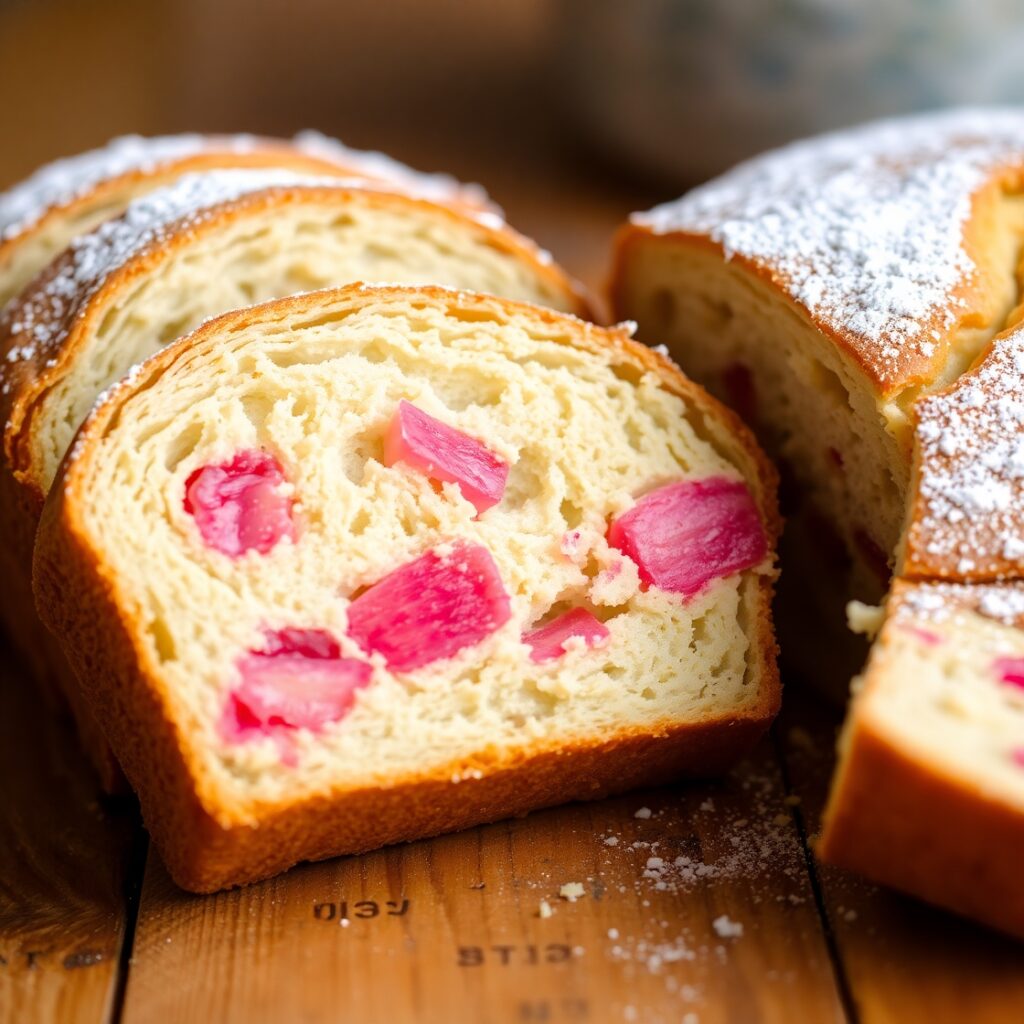
There’s something deeply nostalgic about quick breads. Unlike the structured perfection of cakes or the intensity of yeast-risen loaves, quick breads invite you into a more relaxed, homey space. Rhubarb bread holds a special charm because it embraces contrast—it’s both tart and sweet, rustic and elegant, dense but moist.
One of the biggest reasons people return to this recipe is its ease. You don’t need fancy tools or complicated steps—just a bowl, a whisk, and fresh or frozen rhubarb. It’s a simple bake that gives back so much flavor.
Rhubarb itself is also a star ingredient we don’t use often enough. It brings brightness without overpowering sweetness, which makes the bread feel more balanced. The addition of cinnamon adds warmth, while a little buttermilk or sour cream tenderizes the crumb, giving you a beautifully soft bite that’s still sturdy enough to slice.
This recipe is also incredibly forgiving. Whether you’re using homegrown rhubarb, market-fresh stalks, or even frozen pieces, it comes together beautifully. And because it keeps well for several days, it’s great for make-ahead breakfasts, lunchbox treats, or afternoon snacks.
Ingredients for Rhubarb Bread
To make a great rhubarb bread, you need a few pantry staples and one very important vegetable—that’s right, rhubarb is technically a veggie, even though we treat it like a fruit when baking.
Here’s what you’ll need:
Rhubarb
Fresh rhubarb is best for texture, but frozen works just fine if that’s what you have. Be sure to chop it into small pieces (½ inch chunks). You’ll need about 1½ cups for this recipe. Avoid the leaves—they’re toxic and should never be consumed.
All-Purpose Flour
The base of the bread. It gives structure and holds everything together.
Granulated Sugar
We use sugar to balance rhubarb’s tartness. It sweetens the bread just enough without making it feel like cake.
Eggs
Eggs act as a binder and provide richness.
Buttermilk or Sour Cream
Either one works to add moisture and a little tang. Buttermilk helps soften the crumb while giving a slight lift. If you don’t have it, see the substitutions section below.
Vegetable Oil or Melted Butter
Oil keeps the crumb soft and moist for days. Butter adds a bit more flavor, so feel free to use either depending on your preference.
Vanilla Extract
For depth and aroma. You don’t want to skip this.
Baking Soda and Baking Powder
These leaveners help the bread rise and create a light, fluffy texture.
Salt
Just a pinch enhances flavor and balances the sweetness.
Cinnamon (Optional but Recommended)
Adds warmth and pairs beautifully with the rhubarb. It’s subtle but noticeable.
How Much Time Will You Need?
From start to finish, you’re looking at about 1 hour and 15 minutes:
- Preparation time: 15–20 minutes
- Baking time: 50–55 minutes
- Cooling time: 10–15 minutes before slicing
It’s a straightforward recipe that doesn’t require hands-on supervision once it’s in the oven, making it perfect for a weekend morning or midweek bake.
How to Make This Rhubarb Bread
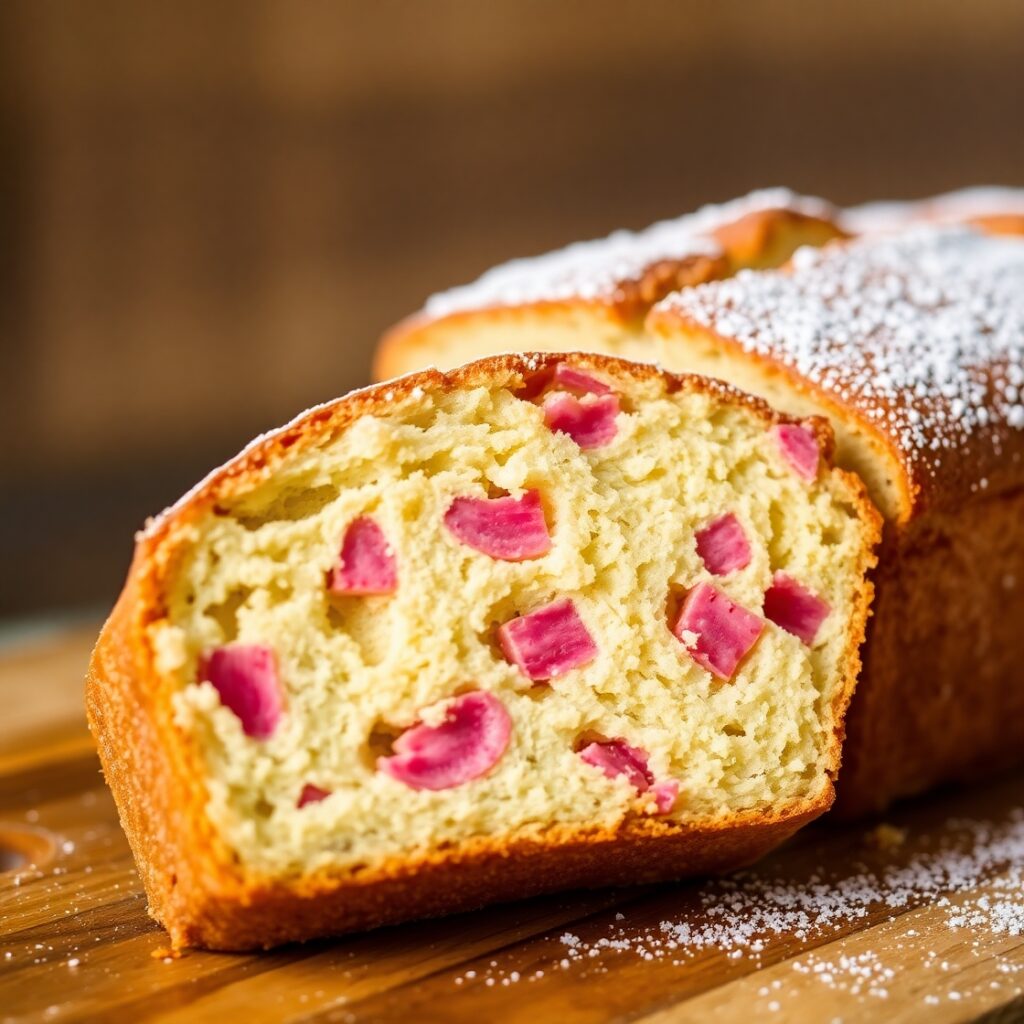
Here’s a detailed step-by-step guide to make sure your rhubarb bread turns out perfect every single time.
Step 1: Preheat and Prepare the Pan
Preheat your oven to 350°F (175°C).
Grease a standard 9×5 inch loaf pan with butter or oil. Line it with parchment paper if you’d like easy removal.
Step 2: Chop the Rhubarb
Wash and trim the ends of your rhubarb stalks.
Chop into small, even ½-inch pieces. This helps them distribute evenly through the bread and ensures tender bites.
Step 3: Mix the Dry Ingredients
In a medium bowl, whisk together:
- 2 cups of all-purpose flour
- 1 teaspoon of baking soda
- ½ teaspoon of baking powder
- ½ teaspoon of salt
- ½ teaspoon of cinnamon (optional)
Set aside.
Step 4: Combine the Wet Ingredients
In a large bowl, beat:
- 1 cup of granulated sugar
- 2 large eggs
- ½ cup of vegetable oil or melted butter
- 1 teaspoon of vanilla extract
Mix until smooth and slightly pale.
Add in 1 cup of buttermilk or sour cream and stir until combined.
Step 5: Combine Wet and Dry
Gradually add the dry mixture into the wet ingredients.
Mix gently with a spatula or whisk—don’t overmix. The batter should be thick but smooth.
Step 6: Fold in the Rhubarb
Gently fold in the chopped rhubarb using a spatula. Be careful not to overwork the batter here. You want the rhubarb evenly distributed.
Step 7: Transfer to Pan and Smooth the Top
Pour the batter into your prepared loaf pan.
Tap the pan lightly on the counter to release any air bubbles. Smooth the top with a spatula.
(Optional: sprinkle a little coarse sugar on top for a slight crust.)
Step 8: Bake
Place in the center of your oven and bake for 50 to 55 minutes.
Check doneness by inserting a toothpick or skewer into the center—it should come out clean or with just a few crumbs.
Step 9: Cool and Slice
Let the bread cool in the pan for about 10 minutes.
Then remove and let it cool completely on a wire rack before slicing. This helps the texture set and avoids crumbling.
Substitutions
Sometimes you’re out of an ingredient—or maybe you want to tweak the recipe for dietary needs. Here are some smart substitutions that still deliver great results.
Buttermilk Substitute
If you don’t have buttermilk, use 1 cup of milk with 1 tablespoon of lemon juice or vinegar. Let it sit for 5 minutes before using. You can also use plain yogurt or sour cream.
Oil Alternatives
You can use melted butter for richer flavor or even coconut oil for a mild tropical hint. If you’re looking for a lower-fat option, unsweetened applesauce can replace half the oil.
Gluten-Free Flour
Use a 1-to-1 gluten-free baking mix in place of all-purpose flour. Be sure it contains xanthan gum or similar binding agents.
Cinnamon Swap
Not a fan of cinnamon? Try cardamom for a more floral note or nutmeg for earthiness.
Sugar Adjustments
Feel free to use brown sugar for added depth. For a lighter version, you can reduce the sugar by ¼ cup, though it will slightly alter the texture and sweetness.
Best Side Dishes for Rhubarb Bread
While rhubarb bread is wonderful on its own, these side pairings can elevate your experience and turn a simple slice into a more complete moment:
1. Greek Yogurt with Honey and Berries
The creamy tang of yogurt pairs beautifully with the sweet-tart bread.
2. Earl Grey or Herbal Tea
Something floral or citrusy to sip alongside helps highlight the rhubarb’s brightness.
3. Soft Scrambled Eggs
If you’re serving this bread at brunch, a plate of delicate eggs adds protein and a savory balance.
Serving and Presentation Tips
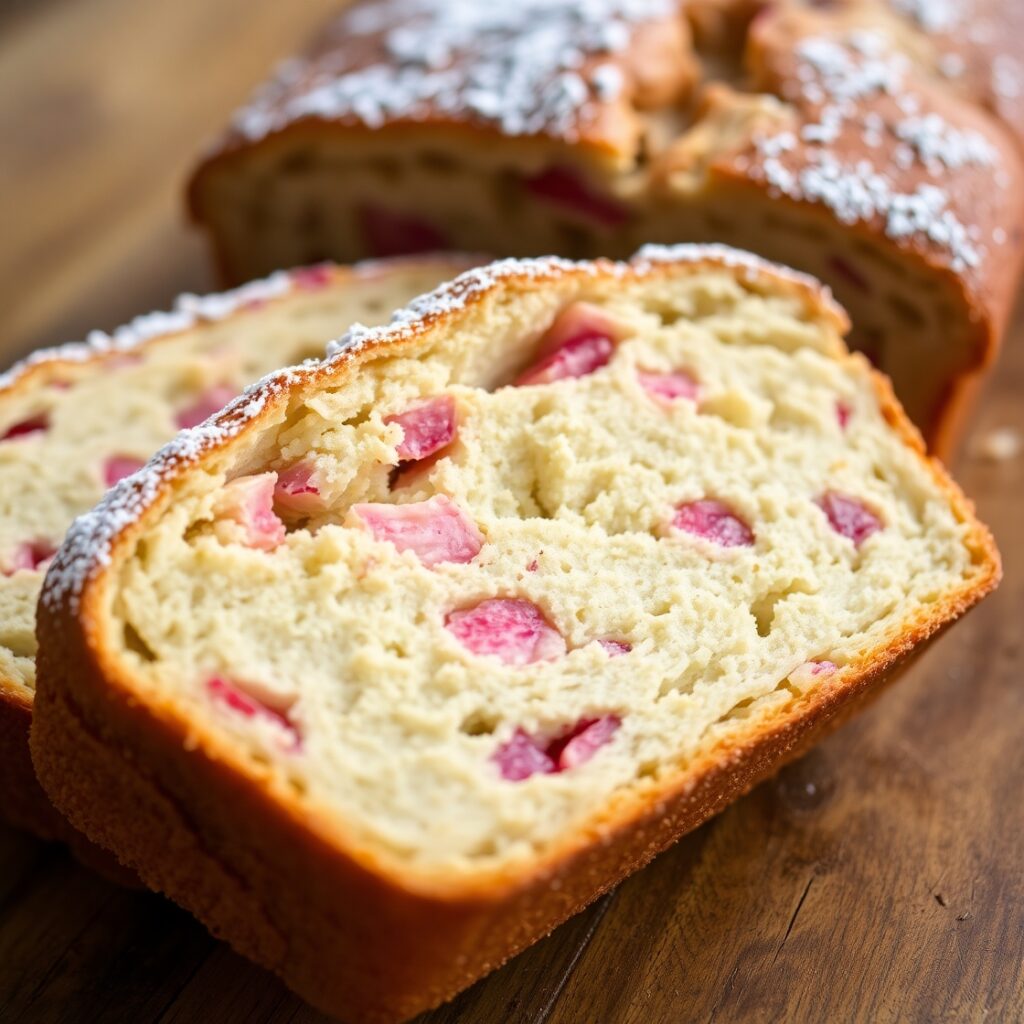
Rhubarb bread is rustic by nature, but that doesn’t mean it can’t be beautifully presented. A few simple steps can turn this humble loaf into a table-worthy centerpiece.
Serve it Warm or Room Temperature
For the most flavor, serve the bread slightly warm. This brings out the sweetness of the rhubarb and softens the crumb to its most tender texture. If serving the next day, a 10-second warm-up in the microwave works wonders.
Add a Light Glaze or Powdered Sugar (Optional)
If you’re aiming for a slightly dressier look—especially when serving to guests—a light lemon glaze or dusting of powdered sugar on top adds visual appeal without overpowering the loaf.
Slice with a Serrated Knife
To get clean slices, use a serrated knife and let the bread cool fully before cutting. If sliced too early, it may crumble due to its soft texture.
Plating Tip
Serve individual slices on a white plate with a few fresh rhubarb slices or seasonal berries on the side. Garnish with a mint sprig for a fresh pop of color.
Tips and Tricks to Make This Recipe Better
If you want rhubarb bread that’s tender in the center, golden on top, and bursting with flavor, these tips will elevate your bake.
Don’t Overmix
This is one of the most important rules for a tender quick bread. Overmixing can lead to dense, tough texture. Mix until the dry ingredients are just incorporated.
Use Fresh Rhubarb When Possible
Fresh rhubarb delivers the best texture—slightly soft but not mushy. If using frozen rhubarb, thaw and drain it well before folding it into the batter to avoid excess moisture.
Let It Rest Before Slicing
It’s tempting to cut into the loaf straight from the oven, but letting it rest ensures it firms up and slices cleanly.
Test for Doneness
Oven temperatures vary, so start checking your bread at 48 minutes. Use a toothpick or skewer to test the center—it should come out with moist crumbs, not raw batter.
Add a Topping for Crunch
Sprinkling coarse sugar or even chopped nuts over the top before baking gives a wonderful texture contrast.
Double the Batch for Freezing
This bread freezes well, so make two loaves at once—one to eat now and one to save for later.
Common Mistakes to Avoid
Skipping the Cooling Time
Cutting too soon can result in a gummy texture. Always let the bread cool at least 10–15 minutes before slicing.
Too Much Rhubarb
Adding more than 1½ cups can cause soggy or uneven baking. Stick to the recommended amount unless you’re adjusting the rest of the batter.
Overmixing the Batter
Overworking the batter can make your bread dense and chewy. Mix only until the dry ingredients are absorbed.
Using Rhubarb Leaves
Rhubarb leaves are toxic and should never be used in cooking. Always discard them and use only the stalks.
Improper Pan Size
Using a pan that’s too small will lead to overflowing or underbaking. Stick with a standard 9×5 inch loaf pan.
How to Store It
Room Temperature:
Wrap the cooled bread tightly in plastic wrap or foil. Store at room temperature for up to 3 days. It’s best enjoyed within the first 48 hours.
Refrigeration:
If your kitchen is warm or humid, refrigerate the bread in an airtight container. This extends freshness to about 5–6 days, though the texture may firm up slightly.
Freezing Instructions:
Wrap individual slices or the entire loaf in plastic wrap, then place in a freezer-safe bag. Freeze for up to 3 months. Thaw overnight in the fridge or reheat a slice in the microwave for 30 seconds.
FAQ
Q: Can I use frozen rhubarb in this recipe?
Yes. Thaw completely and drain excess liquid before using to prevent soggy bread.
Q: Can I make this bread gluten-free?
Yes. Use a 1:1 gluten-free flour blend that contains xanthan gum or a binder. The results are slightly denser but still delicious.
Q: Is this bread very sweet?
No. It’s lightly sweet with a gentle tartness from the rhubarb. If you prefer a sweeter loaf, you can increase sugar by ¼ cup.
Q: Can I add nuts or other mix-ins?
Absolutely. Chopped walnuts, pecans, or even a handful of white chocolate chips pair nicely with rhubarb.
Q: Can I bake this as muffins instead?
Yes. Divide the batter into a lined muffin tin and bake at 350°F for 18–22 minutes. Perfect for portioned treats.

Rhubarb Bread Recipe
- Total Time: 1 hour 10 minutes
- Yield: 1 loaf (10 slices)
- Diet: Vegetarian
Description
This rhubarb bread recipe brings together the tangy brightness of fresh rhubarb and the comforting sweetness of a soft, moist loaf. With simple ingredients and an easy process, this is the perfect bake for spring or any time you’re craving a rustic, satisfying quick bread. A touch of cinnamon and a splash of vanilla add warmth and depth, while buttermilk creates an irresistibly tender crumb. Whether served for breakfast, brunch, or as a midday snack, this rhubarb bread is always a hit.
Ingredients
- 2 cups all-purpose flour
- 1 tsp baking soda
- ½ tsp baking powder
- ½ tsp salt
- ½ tsp cinnamon (optional)
- 1 cup granulated sugar
- 2 large eggs
- ½ cup vegetable oil or melted butter
- 1 cup buttermilk or sour cream
- 1 tsp vanilla extract
- 1½ cups diced rhubarb
Instructions
-
Preheat oven to 350°F (175°C). Grease a 9×5 inch loaf pan.
-
In a bowl, whisk flour, baking soda, baking powder, salt, and cinnamon.
-
In another bowl, beat sugar, eggs, oil, and vanilla until smooth. Stir in buttermilk.
-
Combine wet and dry ingredients. Mix just until incorporated.
-
Fold in chopped rhubarb gently.
-
Pour batter into the pan and smooth the top.
-
Bake for 50–55 minutes or until a toothpick comes out clean.
-
Cool in pan for 10 minutes, then transfer to a wire rack to cool completely.
Notes
Frozen rhubarb works well—just thaw and drain it thoroughly.
Try topping the batter with a sprinkle of coarse sugar or chopped walnuts before baking.
Store at room temperature for up to 3 days or freeze for up to 3 months.
- Prep Time: 15 minutes
- Cook Time: 50-55 minutes
- Category: Quick Bread
- Method: Baking
- Cuisine: American
Nutrition
- Serving Size: 1 loaf (10 slices)
- Calories: 210

